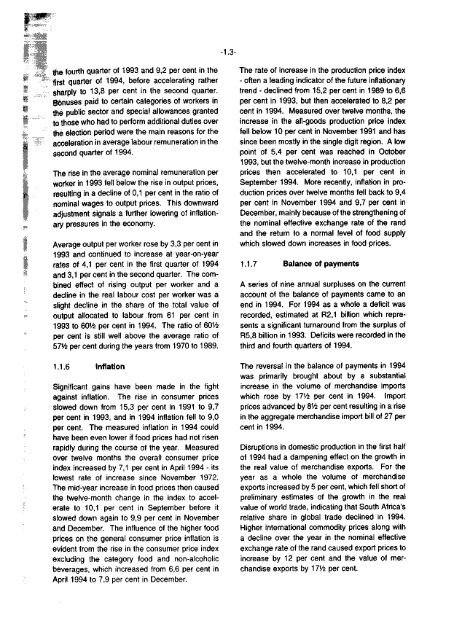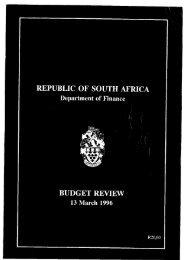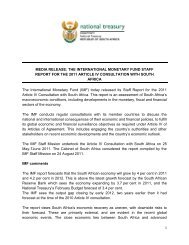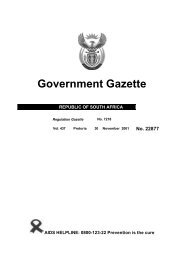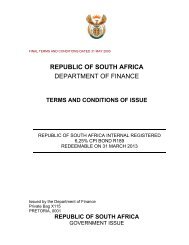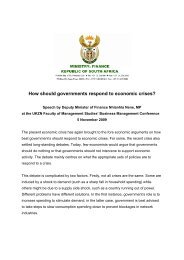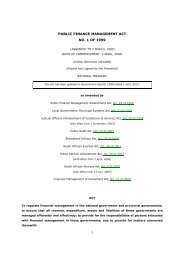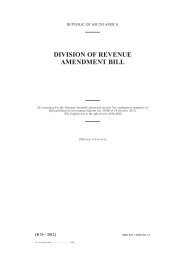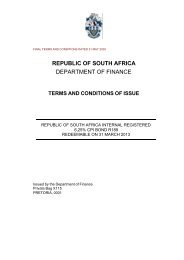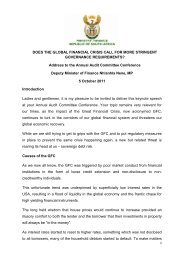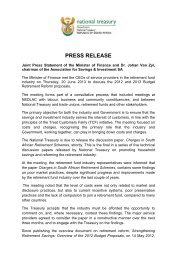1995 - National Treasury
1995 - National Treasury
1995 - National Treasury
Create successful ePaper yourself
Turn your PDF publications into a flip-book with our unique Google optimized e-Paper software.
-1.3-<br />
the fourth quarter of 1993 and 9,2 per cent in the<br />
first quarter of 1994, before accelerating rather<br />
sharply to 13,8 per cent in the second quarter.<br />
Bonuses paid to certain categories of workers in<br />
the public sector and special allowances granted<br />
to those who had to perform additional duties over<br />
the election period were the main reasons for the<br />
acceleration in average labour remuneration in the<br />
second quarter of 1994.<br />
The rise in the average nominal remuneration per<br />
worker in 1993 fell below the rise in output prices,<br />
resulting in a decline of 0,1 per cent in the ratio of<br />
nominal wages to output prices. This downward<br />
adjustment signals a further lowering of inflationary<br />
pressures in the economy.<br />
Average output per worker rose by 3,3 per cent in<br />
1993 and continued to increase at year-on-year<br />
rates of 4,1 per cent in the first quarter of 1994<br />
and 3,1 per cent in the second quarter. The combined<br />
effect of rising output per worker and a<br />
decline in the real labour cost per worker was a<br />
slight decline in the share of the total value of<br />
output allocated to labour from 61 per cent in<br />
1993 to 6OV2 per cent in 1994. The ratio of 6OV2<br />
per cent is still well above the average ratio of<br />
57 1 /2 per cent during the years from 1970 to 1989.<br />
1.1.6 Inflation<br />
Significant gains have been made in the fight<br />
against inflation. The rise in consumer prices<br />
slowed down from 15,3 per cent in 1991 to 9,7<br />
per cent in 1993, and in 1994 inflation fell to 9,0<br />
per cent. The measured inflation in 1994 could<br />
have been even lower if food prices had not risen<br />
rapidly during the course of the year. Measured<br />
over twelve months the overall consumer price<br />
index increased by 7,1 per cent in April 1994 - its<br />
lowest rate of increase since November 1972.<br />
The mid-year increase in food prices then caused<br />
the twelve-month change in the index to accelerate<br />
to 10,1 per cent in September before it<br />
slowed down again to 9,9 per cent in November<br />
and December. The influence of the higher food<br />
prices on the general consumer price inflation is<br />
evident from the rise in the consumer price index<br />
excluding the category food and non-alcoholic<br />
beverages, which increased from 6,6 per cent in<br />
April 1994 to 7,9 per cent in December.<br />
The rate of increase in the production price index<br />
- often a leading indicator of the future inflationary<br />
trend - declined from 15,2 per cent in 1989 to 6,6<br />
per cent in 1993, but then accelerated to 8,2 per<br />
cent in 1994. Measured over twelve months, the<br />
increase in the all-goods production price index<br />
fell below 10 per cent in November 1991 and has<br />
since been mostly in the single digit region. A low<br />
point of 5,4 per cent was reached in October<br />
1993, but the twelve-month increase in production<br />
prices then accelerated to 10,1 per cent in<br />
September 1994. More recently, inflation in production<br />
prices over twelve months fell back to 9,4<br />
per cent in November 1994 and 9,7 per cent in<br />
December, mainly because of the strengthening of<br />
the nominal effective exchange rate of the rand<br />
and the return to a normal level of food supply<br />
which slowed down increases in food prices.<br />
1.1.7 Balance of payments<br />
A series of nine annual surpluses on the current<br />
account of the balance of payments came to an<br />
end in 1994. For 1994 as a whole a deficit was<br />
recorded, estimated at R2.1 billion which represents<br />
a significant turnaround from the surplus of<br />
R5,8 billion in 1993. Deficits were recorded in the<br />
third and fourth quarters of 1994.<br />
The reversal in the balance of payments in 1994<br />
was primarily brought about by a substantial<br />
increase in the volume of merchandise imports<br />
which rose by 17 1 /2 per cent in 1994. Import<br />
prices advanced by 8V2 per cent resulting in a rise<br />
in the aggregate merchandise import bill of 27 per<br />
cent in 1994.<br />
Disruptions in domestic production in the first half<br />
of 1994 had a dampening effect on the growth in<br />
the real value of merchandise exports. For the<br />
year as a whole the volume of merchandise<br />
exports increased by 5 per cent, which fell short of<br />
preliminary estimates of the growth in the real<br />
value of world trade, indicating that South Africa's<br />
relative share in global trade declined in 1994.<br />
Higher international commodity prices along with<br />
a decline over the year in the nominal effective<br />
exchange rate of the rand caused export prices to<br />
increase by 12 per cent and the value of merchandise<br />
exports by 17 1 /2 per cent.


